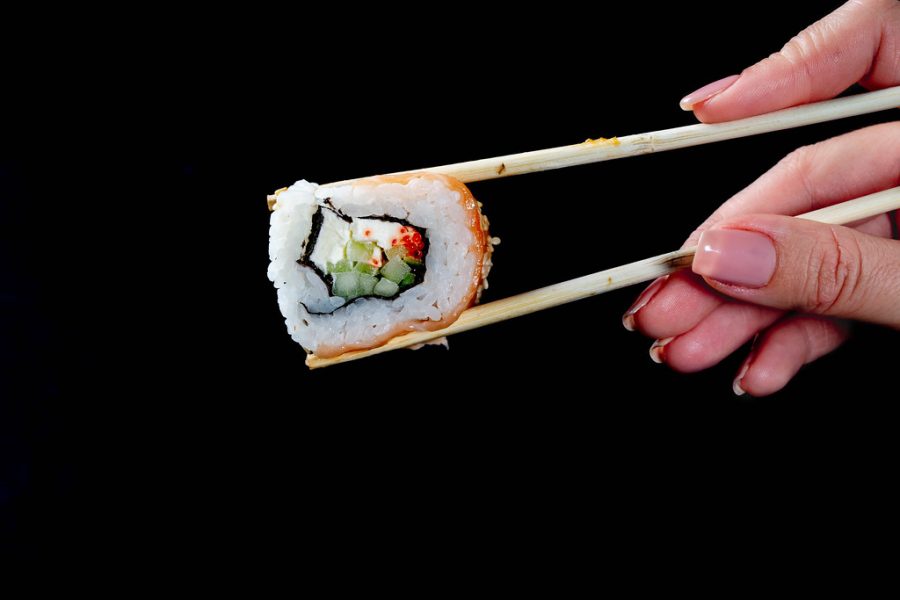The California Roll Wasn’t Invented in California…or Japan
November 22, 2021
From fashion to food trends, everything has its starting place. For sushi, it started in Japan. However, the California roll wasn’t invented in Japan, nor in California. It was actually invented in Canada, and believe it or not, Salmon rolls were also invented in Norway. Here is a brief history of sushi:
- 1971: Sushi was not popular in Japan, as many people found it yucky. People back then only mostly ate tempura and teriyaki. This changed when chef Hidekazu Tojo, a sushi chef, wrapped the rice outside of the much-despised seaweed to hide it instead of wrapping it on the inside. Despite initial backlash, it turned out to be a success, as people enjoyed eating it. Initially called the Inside-Out Roll, it contained imitation crab, avocado, and cucumber, which were daily staples in one’s diet in Japan. It only got the name California roll when people from Los Angeles (LA) came to eat his sushi.
- As the years went by, more additions were added, like salmon and tuna, and customers loved it. It was such a success that Japan’s Ministry of Agriculture and Fisheries appointed him as the nation’s cuisine ambassador. However, salmon and tuna weren’t consumed as much as the Inside-Out Roll.
- Although Chef Hidekazu Tojo came up with the California roll, salmon and tuna sushi weren’t popular and were rarely eaten up until about 1995. In fact, salmon sushi isn’t Japanese! It is Norwegian! Before that, most salmon were pacific salmon, and it usually contained parasites so it wasn’t that popular among consumers.
- 1986-1991: Norway had caught too much salmon on hand, and needed to sell it to another country. They chose to sell it to the Japanese, due to their love of raw fish. Bjørn Eirik Olsen is a Norwegian businessman who worked on these matters. He worked with a committee to try to convince Japanese consumers that Atlantic salmon was safe to eat raw, attempting to boost Norway’s economy by selling fish.
- However, they weren’t that convincing and had a hard time making a profit. Even when the committee put salmon on top of the rice to call it salmon rolls, people didn’t appeal to it. In business meetings, they offered their salmon, which others didn’t like.
- “It took actually 10 years to have a proper breakthrough in the market,” described Olsen, to Great Big Story producers.
- In the end, after the acceptance of Pacific salmon, along with the combined efforts of both Olsen and Chef Tojo, the popularity of sushi greatly increased. California rolls and salmon rolls alike became well-known and consumers loved their taste.
- However, with all things, the more popular something is, the greater the demand becomes, which increases the price. Back then, sushi wasn’t as prized and well sought after as it is today, as it was considered a staple food and didn’t cost excessive amounts. Nowadays, an 8-piece roll of sushi can cost anywhere from six to twenty dollars!
“My favorite sushi restaurant is in Silverlake and it’s called Silverfish. I just like to have a plain salmon roll, and I like to eat it with soy sauce, wasabi, and ginger,” junior Caitlyn Vaughn commented. Caitlyn loves to eat sushi and has been eating it since she was 13-years-old and recommends everyone to try it.
Despite sushi becoming more and more popular with prices increasing, there are still restaurants nearby that sell sushi for cheap. The most low-cost sushi places around the LA Area include Sushi Stop and Go Go Sushi. Sushi Stop and Go Go Sushi both are the most affordable sushi restaurants nearby, with prices as low as $7. For example, Sushi Stop sells 8-piece dragon rolls for $7.59 and eel avocado rolls drizzled in a teriyaki sauce are as low as $5.95. Go Go Sushi also offers sushi rolls, under their category of ‘Basic Rolls’ at affordable prices, like their salmon roll for $5.19. Another place, Mikomi Sushi, also offers relatively low prices and there’s a location in Monrovia.
Photographic Courtesy of FLICKR.COM

